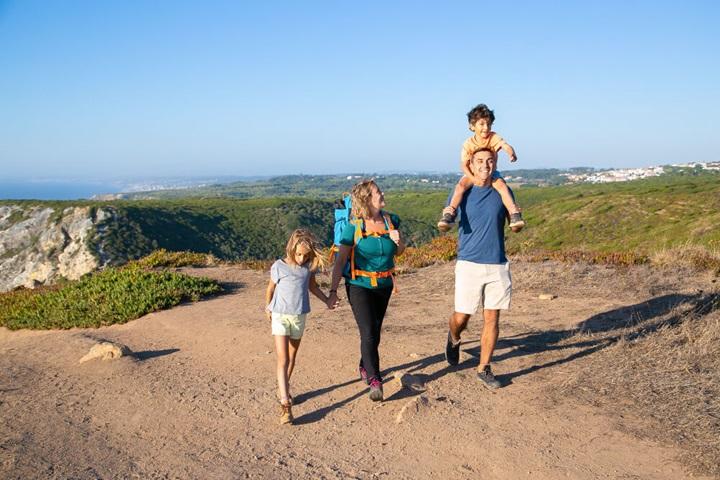Ever thought about swapping school runs for safaris or history lessons for hands-on ruins? With world schooling, the world really can become your child’s classroom.
Worldschooling is an alternative way of learning that blends education with travel, allowing children to learn through real-life experiences while staying on track with their studies. In this article, we’ll explore how worldschooling works, how it compares to homeschooling, benefits and challenges, and the practical steps to get started.
Key Points:
- World schooling uses travel and real-world experiences as a primary way to learn.
- It can be short-term or long-term, flexible around your lifestyle and budget.
- Online learning tools can support key subjects like Maths and English while on the move.
- Families don’t need to follow a set curriculum—but structure helps.
- It’s not always easy, but the rewards are huge for both parents and children.
What Is Worldschooling?
Worldschooling (or world schooling) turns every city street, nature trail, and local market into a live lesson. Rather than working through worksheets indoors, children can use real-time experiences such as sights, sounds, and people to understand history, geography, languages, and more. A trek along Hadrian’s Wall, for example, could explain Roman Britain better than any slideshow; counting pesos at a Mexican food stall will test their mental maths faster than flashcards, and so on.
There’s no fixed timetable or minimum trip length—the guiding idea is simple: move beyond four walls and let the wider world spark curiosity.
Who Can Try World Schooling?
In theory, any family can embrace worldschooling.
In practice, three factors should be considered:
- Money
- Work flexibility
- Local rules
Some parents freelance online; others rent out the family home to fund slow travel. Age matters too—primary-age children usually slot into portable study routines more smoothly than teens facing exams. If you still want structured learning while on the move, pairing travel with a recognised online syllabus can keep progress clear – explore flexible online courses with qualifications.
Worldschooling vs homeschooling
Both schooling methods sit outside mainstream school environments, but their day-to-day feel is entirely different.
Homeschooling families usually keep a home base and dip into nearby clubs, libraries, and museums.
Worldschooling families trade that base for a rolling itinerary—Tokyo in spring, Lisbon come autumn—letting location drive each new topic.
A homeschooled child might study volcanoes from a book; a world-schooled peer can walk the lava fields of Lanzarote the same week.
What both approaches share is freedom to tailor pace, depth, and method to the child rather than to the school bell.
For many parents, weaving the two together—steady online classes plus place-based projects—delivers the best of both worlds in a way that’s doable and memorable.
How To Begin World Schooling
With world schooling, there is no licence, membership, or test. Parents first clarify finances—remote work, rental income, or savings—then check the legal position on home education at each stop. If children are already enrolled in school, written deregistration is normally needed before departure.
Once the administrative tasks are done, the family chooses a first base with reliable internet, affordable living costs, and cultural variety. From there, learning plans evolve alongside the itinerary.
Who Teaches During Worldschooling?
Some parents adopt an unschooling approach, allowing curiosity to set the day’s agenda. Others retain structure through online lessons in core subjects.
Using reputable digital learning platforms means qualified teachers can cover maths and languages while adults handle project work in museums, nature reserves, or community initiatives. A brief weekly record—photos, reading logs, or assignment screenshots—meets most UK local-authority requests for evidence.
Tools and resources
Packing light is easier than ever. A small laptop or tablet, noise-cancelling headphones, a Kindle, and a lined notebook form the basic kit.
Cloud storage keeps worksheets safe; translation apps support language practice on the street. Many worldschooling families also carry a compact science kit (magnifying glass, pH strips) for spontaneous field experiments.
| Recommended Items | Purpose |
| Lightweight laptop | Online classes and research |
| Kindle or e-reader | Reading without heavy books |
| Travel journal | Handwriting and reflection |
| Portable science kit | Practical investigations |
Fitting Worldschooling To A Recognised Curricula
Daily experiences cover history, geography, and social studies almost by default, but algebra and essay writing still need deliberate practice. Families aiming for GCSEs or A-levels typically follow a structured online syllabus, scheduling lessons early in the day before heading out to explore.
Those who prefer a broader outlook may mix subject-based study with project portfolios, focusing on competence rather than age-based targets. Either route demonstrates that worldschooling can meet academic goals while nurturing global understanding.
Do Children Fall Behind With Worldschooling?
Evidence from families who follow world schooling suggests the opposite. Real-time encounters with new cultures, climates, and languages accelerate understanding and spark confidence.
When an online syllabus travels with the child, lessons adapt to ability, not age, letting quicker learners progress early to exam content. The varied settings also build resilience and flexibility—traits valued in university admissions interviews and future workplaces.
Core Benefits of Worldschooling
| Advantages | Why It Matters |
| Deeper, memorable learning | Physical contact with history such as touch and smell can anchor in lived experiences that couldn’t be replicated in the classroom. |
| Global awareness | Regular interaction with different customs and viewpoints fosters open-minded, respectful communication. |
| Adaptive life skills | Navigating airports, planning budgets, and solving daily travel hurdles build independence and problem-solving capacity. |
| Flexible pacing | Progress in maths or languages can be accelerated through tailored online learning courses, while slower areas receive extra time. |
| Family connection | Shared projects and discoveries replace rushed school runs, strengthening parent–child collaboration. |
Monitoring Progress
Parents concerned about academic tracking can pair worldschooling with recognised distance-learning providers. Regular assessments, grade reports, and tutor feedback deliver clear reference points for re-entry into mainstream schooling or future exam routes.
Simple evidence—photos of fieldwork, reading logs in cloud folders, and completed assignments—meets most UK local-authority requirements.
Long-Term Impact
Early studies on mobile learning highlight increased engagement and stronger retention when content links directly to the students’ surroundings. Parents also report higher motivation: children choose to research topics encountered on the road, lifting reading volume and critical thinking without persuasion.
While each child is unique, combining world schooling with structured online support offers a balanced path that preserves academic options and widens horizons.
Challenges of World Schooling
There are some factors that parents need to be aware of when preparing for world schooling with their children:
Maintaining Friendships
A mobile lifestyle can limit deep, long-term bonds. Children meet playmates in parks or hostels, but those connections end when the bus leaves. Regular video calls with friends at home and joining local sport or drama clubs in each location help bridge that gap and keep social skills growing.
Money and Budget
Unlike a holiday, world schooling requires everyday living costs on the road. Slow travel in lower-cost regions, house-sitting, and remote work can keep spending predictable, yet sudden visa fees or health bills still appear. A clear travel budget and an emergency fund are prudent before departure.
Stability and Routine
Frequent moves can unsettle study habits. Worldschooling families often keep a fixed online-class timetable—mornings for Maths and English, afternoons for explorations—so learning goals stay visible. Familiar morning rituals, even something as small as the same breakfast, provide extra security for younger children.
Practical Logistics
Consistent internet, medical care, and safe accommodation all need researching prior to the journey. Portable Wi-Fi devices, international health insurance, and booking accommodation a month ahead reduce last-minute stress. Packing light—one carry-on per person—also makes bus and train hops smoother.
Cultural Adjustment
Every new country brings different customs, languages, and food. Preparing basic phrases, observing local etiquette, and keeping a small kit of “home comforts” (favourite snacks, family photos) can soften culture shock.
Over time, these repeated adjustments build cultural agility, turning a potential hurdle into a valuable competence for the future. Parents should model openness, showing children how to ask respectful questions.
15 Top Destinations for Worldschooling
Budget-friendly first steps
- Thailand (Chiang Mai) – Affordable living and strong expat networks make long stays easy.
- Vietnam (Hoi An/Da Nang) – Low daily costs plus vivid history and coastal landscapes.
- Malaysia (Penang/Kuala Lumpur) – Modern amenities, widespread English, and varied cultures suit new world schooling families.
History brought to life
- Mexico (Mérida) – Mayan ruins and colonial streets deliver hands-on archaeology and Spanish immersion.
- Greece (Athens/Crete) – Ancient temples turn textbook myths into visible reality.
- Japan (Kyoto/Nara) – Shrines and samurai history sit alongside efficient public transport for easy fieldwork.
Living science laboratories
- Costa Rica (Manuel Antonio) – Rainforest biodiversity supports daily biology studies.
- Iceland (Golden Circle) – Geysers and glaciers make geology tangible for worldschooling projects.
- New Zealand (Queenstown/Fiordland) – Active volcanoes, fjords, and outdoor sports foster environmental science and physics topics.
Year-round sunshine
- Malta – Reliable Mediterranean warmth plus layered Phoenician, Roman, and British history.
- Canary Islands – Spring-like climate, volcanic parks, and affordable inter-island flights suit multi-stop itineraries.
- Cyprus – Combination of ancient sites and modern infrastructure keeps lessons varied and travel simple.
Ready-made community hubs
- Bali, Indonesia – Established world school meet-ups, co-learning spaces, and family villas with fibre internet.
- Algarve, Portugal – Growing digital-nomad scene, mild winters, and accessible European flights.
- Toronto, Canada – English-speaking base with strong homeschool networks; nearby Manitoulin Island offers outdoor study breaks.
These locations cover varied budgets, climates, and learning goals, giving families multiple starting points for successful world schooling adventures.
FAQs
Do worldschooling families take school exams?
Some do, some don’t. It depends on the family’s goals and the child’s future plans. Those aiming for GCSEs, A-levels, or university entry often register as private candidates and prepare through distance learning providers. Others choose to follow interest-led learning without formal exams.
Can children rejoin mainstream school after worldschooling?
Yes, many do. Re-entry is smoother if the child has followed a recognised curriculum or maintained academic records. For younger children, the transition is often easier. Older students may need to show prior work or complete assessments to be placed in the correct year group.
Do worldschooling children struggle with long-term travel?
Most adapt well, especially when routines are maintained and destinations are chosen with their interests in mind. Some children may take time to adjust, so it helps to include breaks in familiar environments, allow time for rest, and involve them in planning the journey.
Sources
Krokhina, J. A., Kruse, I. I., Khairullina, E. R., Ibragimov, G., Kochneva, L. V., and Pashanova, O. V. (2024). An examination of mobile learning adoption in higher education: Research trends in twenty years. Contemporary Educational Technology, 16(4), ep542. [online] Available at: https://doi.org/10.30935/cedtech/15612 [accessed 25/06/2025]






